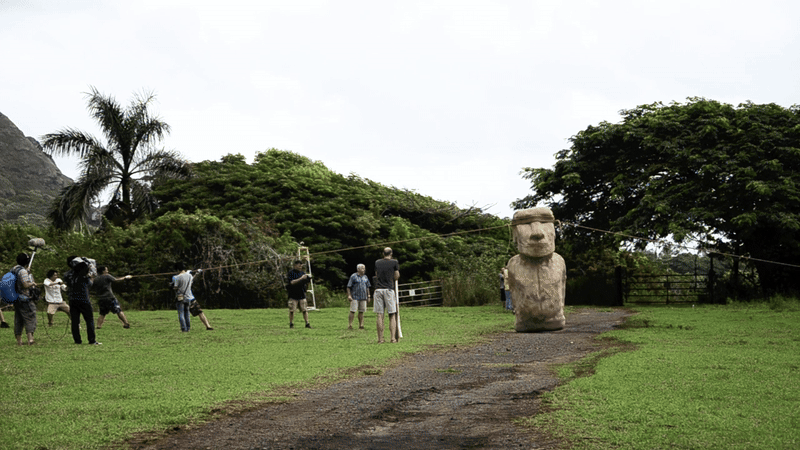The iconic Moai statues of Easter Island have captivated the world for centuries, prompting endless speculation about how these colossal figures were transported across the island. New research offers a compelling explanation, suggesting that the statues may have been ‘walked’ using simple physics and a surprisingly small team of people. This discovery challenges traditional views that assumed vast resources and manpower were necessary for the monumental task.
This article will explore the groundbreaking study that sheds light on the Moai’s transport, delving into the pendulum dynamics that facilitated their movement. We will examine the key features of the statues that enabled this ‘walking’ method, the workforce required, and the implications this research has on our understanding of Rapa Nui society. We’ll also consider an outside perspective on the findings, providing a balanced view of this intriguing archaeological revelation.
The Physics of ‘Walking’ Moai: Pendulum Dynamics
The latest study, published in the Journal of Archaeological Science, reveals that the ingenious transport of Moai statues relied heavily on pendulum dynamics. Anthropologists realized that incomplete Moai statues, which were discarded shortly after being quarried, held key insights. These statues were crafted with a low center of mass and a forward lean, strategically designed to assist in their transport.
Researchers virtually recreated the Moai and discovered that with the assistance of three ropes and a team of 5 to 60 people, the statues could take steps averaging 35 inches. The team virtually recreated the moai and found that, with the help of three ropes and anywhere between five and 60 people, the moai could have taken steps averaging 35 inches (89 centimeters) long to travel across the Rapa Nui landscape.
What we found is the fact that statues were moved with very small numbers of people in an amazingly ingenious way.
This method challenges the long-held belief that Rapa Nui communities needed substantial resources and vast numbers of people to move the Moai statues from the Rano Raraku quarry to their ceremonial positions.
The “Walking” Moai Experiment and Virtual Models
The ‘walking’ Moai hypothesis gained traction following a televised experiment in 2012, where a team of 18 people ‘walked’ a scaled 4.8-ton replica a distance of 328 feet in just 40 minutes. Building on this, Carl Lipo and Terry Hunt created virtual 3D models of 62 ‘road Moai,’ those found along ancient roads. This modeling revealed a distinctive forward lean in these statues, ranging from 6 to 15 degrees, shifting their center of mass and causing them to topple if standing unsupported.
These road Moai also feature a D-shaped base, acting as a pivot point for each step. Furthermore, the absence of eye sockets in these statues, a feature present in all final Moai, suggests that the finishing touches were carved upon arrival at their final destination.
This step of the process was an important piece in the puzzle, researchers found that, depending on the moai’s gigantic size, 15 to 60 people were needed to start the movement and five to 25 to continue it, indicating that this mode of transport was remarkably efficient.
Workforce Requirements and Travel Time
The team’s physics modeling of the ‘walking’ Moai helped determine the workforce needed and the estimated travel time. Using ropes measuring 65 to 98 feet, the researchers incorporated the Moai’s mass and irregular shapes, calculating the force necessary to initiate the ‘walking’ motion.
They found that between 15 and 60 people were needed to start the movement, while only 5 to 25 were required to sustain it. This suggested a remarkably efficient mode of transport. By tugging on the ropes, a rocking motion was created, causing the base to pivot and step forward. Once initiated, pendulum dynamics reduced the effort needed for each subsequent step.
Calculations revealed that the Moai could ‘walk’ approximately 1,000 feet per hour, with larger Moai not necessarily being slower due to their longer strides. An average-sized Moai would have taken around 11,000 steps for a 6.2-mile journey. This suggests that the people of Rapa Nui were brilliant engineers.
An Outside Take: Alternative Interpretations
Sue Hamilton, an archaeologist and professor of prehistory at University College London, acknowledges this research as “an ingenious and worthwhile contribution to the discussion.” However, she suggests that the data could support a range of interpretations beyond the authors’ conclusions. For instance, road Moai may have been engineered differently due to varying ceremonial purposes, different craftsmanship expertise, or trends from specific time periods.
Hamilton emphasizes that this research presents one possibility for how the Rapa Nui people moved the Moai, but other plausible hypotheses exist. The data presented are consistent with a range of interpretations, not just those of the authors. The current work by the authors further demonstrates the technical possibility of upright movement of the statues (moai), but it does not prove that it happened.
Despite these alternative viewpoints, Lipo and Hunt maintain that critics of the ‘walking’ Moai hypothesis have yet to offer plausible alternatives that account for the full range of evidence.
Conclusion: A New Perspective on Rapa Nui Engineering
The recent study proposing that Easter Island’s Moai statues were ‘walked’ using pendulum dynamics offers a fresh perspective on the engineering capabilities of the Rapa Nui people. This research challenges traditional assumptions about the resources and workforce required for such monumental tasks. By demonstrating that a small team of individuals could move these colossal statues with relative ease, the study highlights the ingenuity and resourcefulness of this ancient society.
While alternative interpretations and hypotheses remain, the evidence supporting the ‘walking’ Moai theory provides a compelling explanation that aligns with the physical characteristics of the statues and the available historical context. This revelation reshapes our understanding of Rapa Nui society and its ability to achieve remarkable feats with limited resources. As archaeological research continues, further insights into the mysteries of Easter Island and its iconic Moai statues will undoubtedly emerge.

Leave a Reply